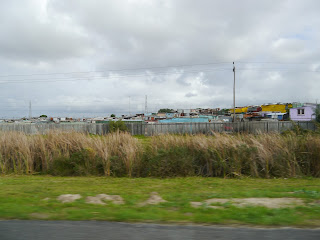South Africa.
What comes to mind when you think of South Africa?
Apartheid? Diamonds? AIDS? Mandela? Probably all of the above. How about sky
scrapers, tin shacks, drinkable water, electricity and American soap operas?
 While the sky scrapers may be a shocker to those who haven’t
visited Cape Town and associate South Africa with the rest of the continent, it
is a fascinating place full of the same touristy gifts as Uganda, Kenya,
Burundi and Rwanda, but with a vibrant culture of its own. The modern
environment is surprising, the grocery store 3 blocks down the road, the sushi
shop, and cake decorator and patisserie next door all provide insights to the
vast diversity of the city of Cape Town.
While the sky scrapers may be a shocker to those who haven’t
visited Cape Town and associate South Africa with the rest of the continent, it
is a fascinating place full of the same touristy gifts as Uganda, Kenya,
Burundi and Rwanda, but with a vibrant culture of its own. The modern
environment is surprising, the grocery store 3 blocks down the road, the sushi
shop, and cake decorator and patisserie next door all provide insights to the
vast diversity of the city of Cape Town.
Cape Town has its beautiful Waterfront, bustling shipping
industry, and delicate suburbs. While few people seem to have much of a
backyard, we are also living in the “college town” area of Cape Town, near
University of Cape Town (UCT). There is a stark contrast between “our” area and
that of the townships where we work. The townships were initially divided from
the traditionally white areas by cast greenbelts that are now protected
environmental habitats for some of South Africa’s rare plants and animals, but
keeps divisions of people alive. From Lookout Point, you can see much of the
city, and on a not-so-foggy day, you can also see Table Mountain looming up in
the distance.
In the townships, electricity is there- not the rolling
brownout style electricity of Kampala, but electricity comes through “spider
wires” that allows for TVs, stereo systems, and church microphones music to
fill the air. When children are at school, the streets are relatively quiet as
mom’s work or do chores. There are shock and cinder block homes lining the paved
streets and sidewalks. Dogs are common guards of the homes, and makeshift
fences line the streets made of chain-link fences, wood, and barbed wire.
Clothes lines crisscross front yards, and a garden or two can be found walking
around the town we work in. Spaza shops or an American version of a corner
store in nowhere Virginia or Arkansas might best describe them with their
lightly stocked shelves. Taverns are not everywhere, but are definitely
obviously visible. Few buildings are two stories tall, but the licensed taverns
are. The unlicensed shops (un-liquor licensed) spots are common but much
smaller hang-outs.
Poverty is very different here in South Africa. It is not
quite like urban America, but is not far from the poverty of Appalachia. Social
programs exist- disability grants, pensions, and more! Multi-room homes with 2 people
or 1 person in a room the size of my dorm room in college. Nothing like
Kampala’s slums with 10 people sleeping in a one room shack or like in Nakivale
with nothing inside the homes but a grass mat, jerry can and a pot to cook in.
These houses have stuff. Knick-knacks. Chalk-ware cocker spaniels glazed in
various colors, TVs, radios, pots, dishes, couches. Only the Somali refugees of
Nakivale had anything like this in Uganda’s poor. Surely not all township
residents are living the way we see things, but many are. They have social
programs and there are not swollen bellies and ribs showing on the average child.
 Boredom is often seen in the poor and unemployed, and the
townships are no exception. I will write more on this another day, but violence
and crime are starting up in our host’s township due to this ‘boredom’. Rugby,
school and work take away from the boredom of some, but not for everyone. This
trip will be full of complexity, full of ambiguity, secrecy and historical
influences. I’ll do my best to keep everyone up to date!
Boredom is often seen in the poor and unemployed, and the
townships are no exception. I will write more on this another day, but violence
and crime are starting up in our host’s township due to this ‘boredom’. Rugby,
school and work take away from the boredom of some, but not for everyone. This
trip will be full of complexity, full of ambiguity, secrecy and historical
influences. I’ll do my best to keep everyone up to date!
To end on a lighter note... the flowers here are made by one of the men living in the township out of old aluminum cans! Through varnish and paint their new flower formations are quite lovely! Flowers by Golden may yet make it to the States....


